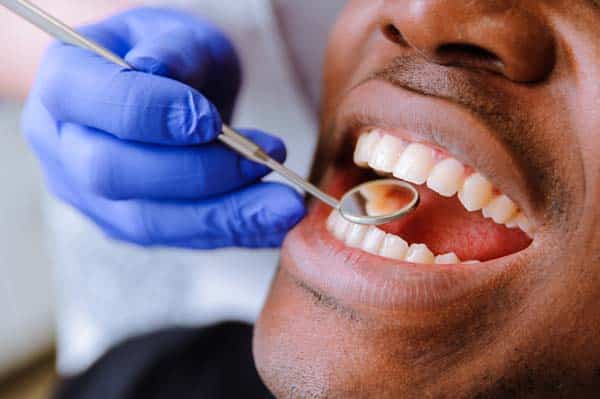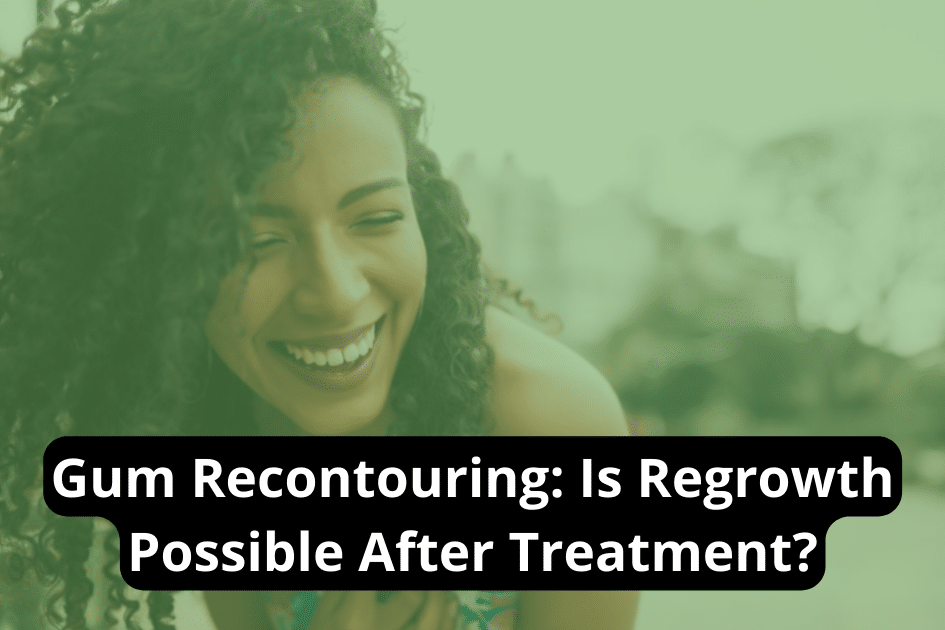Close to half the adult population suffers from gum disease. This prompts a detailed look at gum recontouring. The focus will be on the potential for regrowth following treatment, the best practices for post-treatment gum care, and alternative solutions.
Understanding Gum Recontouring
You might be curious about gum recontouring, so let us explain it clearly. Known alternatively as gingival sculpting, gum recontouring is a procedure in cosmetic dentistry that alters the gum line to improve the look of your smile. Many clients at Cedar Park Dental have witnessed significant transformations in their smiles with this technique.
Gum recontouring often plays a part in large-scale smile makeovers. It is particularly useful for those who have gummy smiles, where the gums are more visible than the teeth when smiling. By carefully removing excess gum tissue and reshaping the leftover gums, Dr. Dale Williams can achieve a harmonious proportion between your gums and teeth.
The procedure uses cutting-edge laser technology to ensure precision and lessen discomfort during the operation. The laser immediately seals off blood vessels, which drastically cuts down on bleeding and recovery time compared to older methods.
When it comes to regrowth after the procedure, significant regrowth is rare if the operation has been carried out correctly. However, minor changes in the contour might occur due to natural healing processes or changes in oral health habits after the procedure.
Now that you have a better grasp of what gum recontouring involves, let’s discuss the reasons why individuals opt for this procedure.
The Possibility of Gum Regrowth

Notably, the chances of your oral tissue recovery post-procedure hinge on personal factors such as overall health and dental hygiene. For example, if you live a healthy lifestyle in Cedar Park, TX, and are meticulous about your dental care routine, you may have an improved chance of achieving optimal gum regrowth after recontouring.
It is important to clarify that some degree of gum regrowth is possible after treatment. However, the amount is typically minimal to none. The healing process is indeed personal to each patient. Elements such as age, overall health condition, and genetics significantly influence how well and quickly one recovers from this type of procedure.
Regarding misconceptions surrounding gum recontouring in Cedar Park, it is crucial to dispel these. A prevalent misconception is that gums will fully regrow post-treatment. Regrettably, this is not correct. Gum tissues do not regenerate in the same way as other body tissues. Once they have been contoured or removed during the procedure, they usually do not regrow.
Lastly but importantly, any concerns related to potential gum regrowth should be shared with your dentist prior to undergoing treatment. This allows them to offer personalized advice that suits your particular situation.
Post-Treatment Care and Maintenance
After your procedure, it is important to remember that a strong oral hygiene routine is vital for ideal healing and avoiding any unnecessary complications. Post-treatment care is crucial for your recovery and also helps manage the risk of gum regrowth.
We emphasize the significance of these four key steps:
1. Regular Brushing: Utilize a soft-bristled toothbrush to clean your teeth a minimum of twice daily.
2. Flossing: This step is essential! It aids in the removal of plaque build-up that brushing alone cannot reach.
3. Routine Dental Check-ups: These enable us to track your healing process and promptly handle any issues that may surface.
4. Avoid Tobacco and Alcohol: Both have the potential to disrupt gum healing and cause other oral health problems.
Beyond this, it’s critical to watch for signs such as extended bleeding or swelling, intense pain, or fever following the procedure as these might suggest an infection.
Bear in mind, we are dedicated to assisting you in maintaining healthy gums post-gum recontouring treatment. By adhering to these guidelines, you are actively working towards preventing unwanted gum regrowth and promoting overall dental health.
Alternatives and Complementary Treatments to Gum Recontouring
Let’s examine other dental procedures that might serve as alternatives or complements to reshaping your gums. We will discuss the most common treatments and how they stand up against gum recontouring.
| Treatment | Comparison to Gum Recontouring |
| Scaling and Root Planing | This procedure involves deep cleaning, removing plaque and tartar from below the gum line, and addressing periodontal disease. It doesn’t reshape, but it supports overall gum health. |
| Gum Graft Surgery | This surgery repairs receding gums by transplanting tissue. It can modify the gumline’s shape but is more invasive than recontouring. |
| Crown Lengthening | Crown lengthening reveals more tooth surfaces by eliminating excess gum tissue. It provides a result akin to recontouring but might need bone removal. |
| Orthodontics | Orthodontic treatments such as braces rectify alignment issues that affect the gums’ appearance. They don’t directly reshape gums, but can indirectly impact their positioning. |
Choosing between these options relies on your specific needs and preferences. Consult with your dentist to determine what’s best for you based on factors such as cost, recovery time, and anticipated results. Regardless of the choice made, keeping up with good oral hygiene habits after the treatment guarantees the best results.
The Impact of Gum Recontouring on Overall Oral Health

After exploring the possible risks and complications of gum recontouring, we now turn our attention to its effect on overall oral health. It’s essential to comprehend that gum recontouring isn’t just a cosmetic procedure; it also has an important part in maintaining and enhancing oral wellness.
Gum reshaping can significantly aid in improving dental health in a number of ways:
- Teeth and Bite Alignment: Reshaping the gums allows for more tooth surfaces to be exposed for improved cleaning. This minimizes plaque accumulation, which subsequently lowers the risk of cavities and tooth decay. This treatment also has the ability to rectify bite issues caused by uneven gum lines.
- General Gum Health: Correctly reshaped gums decrease areas where bacteria may congregate, leading to enhanced gum health and possibly averting periodontal diseases.
- Long-term Oral Wellness: Healthier gums increase the probability of sustained oral wellness. This not only implies fewer dental problems but also contributes to an attractive smile, which can boost self-confidence.
Consequently, while any surgical procedure, including gum recontouring, carries risks, these should be considered against the enduring positive effect on an individual’s overall oral health.
Conclusion
Gum recontouring can significantly alter your oral health, providing a new perspective. It’s been observed that gum regrowth is achievable when neglecting proper care and maintenance after the procedure.
Other options exist, yet potential risks and complications should be considered. It’s crucial to remember that this decision requires careful thought and consideration, taking into account the benefits and drawbacks of your specific dental situation.


